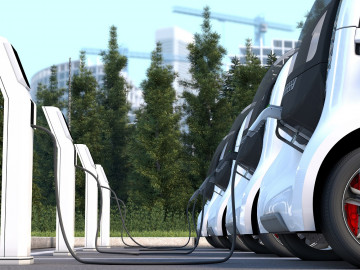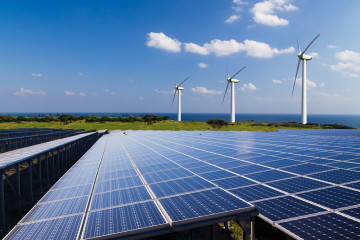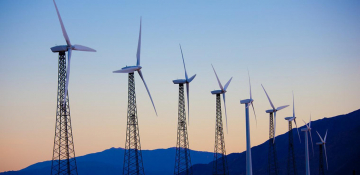
Last year marked a global shift in corporations adopting low-carbon and net zero pledges as experts at the United Nations Climate Change Conference, COP26, declared that the climate crisis is at a critical inflection point. The UN now reports that just over 1,326 corporations have signed the Business Ambition for 1.5°C commitment and 7,126 companies have joined the Race to Zero.
These collective actions have spurred more organizations around the world to make their own low-carbon commitments. We’ll take a look at what’s involved in drafting a carbon reduction plan and highlight a few organizations whose plans serve as an aspirational benchmark in the drive to a low carbon economy.
Solutions that Meet the Challenge
One of the greatest challenges for organizations working toward a net-zero future is addressing all sources of emissions within their processes and value chain.
To understand the progress that’s been made, it’s important to know how emissions are classified. Developed as an international accounting standard by the Greenhouse Gas Protocol, emissions are separated into three categories:
Scope 1: Direct emissions
These emissions come from sources that are directly owned or controlled by the company and represent the most straightforward category to measure and address. Examples include:
- Mobile emissions from company fleet vehicles
- Stationary emissions from on-site heating fuels
- Process emissions produced by manufacturing or production
- Fugitive emissions like leaking refrigeration or air conditioning units
Scope 2: Utilities emissions
Utility-related emissions form a significant portion of many organizations' carbon footprints and often present clear opportunities for reduction through renewable energy adoption. These include:
- Electricity
- Steam
- Heating
- Cooling
Scope 3: Indirect emissions
This category encompasses the broadest range of emission sources and typically accounts for the largest portion of an organization's total greenhouse gas emissions. These can include:
- Purchased goods and services
- Capital goods
- Fuel- and energy-related activities
- Upstream transportation and distribution
- Waste generated in operations
- Business travel
- Employee commuting
- Upstream leased assets
- Downstream transportation and distribution
- Processing of sold products
- Use of sold products
- End-of-life treatment of sold products
- Downstream leased assets
- Franchises
- Investments
While many organizations have made headway on crafting plans that reduce Scope 1 and Scope 2 emissions, Scope 3 remains a challenge due to its size and complexity. Fortunately, as more organizations lower their direct emissions, the companies that make up supply and value chains collectively move closer to net-zero.
7 Companies Setting a Strong Example for a Net-Zero Carbon Emissions Future
These seven companies are helping lead the way to a carbon-neutral future through ambitious commitments and concrete actions that demonstrate what's possible in climate action. From technology giants to logistics companies, they are showing that significant emissions reductions are achievable across diverse sectors while maintaining business growth and innovation
Microsoft
Industry: Information Technology
Headquarters: United States
In 2020, Microsoft pledged to become carbon negative by 2030, remove historic carbon emissions by 2050, and invest $1B in a climate innovation fund.
At the release of the plan, Microsoft President and Vice-Chair Brad Smith shared, “We are launching today an aggressive program to cut our carbon emissions by more than half by 2030, both for our direct emissions and for our entire supply and value chain. We will fund this in part by expanding our internal carbon fee, in place since 2012 and increased last year, to start charging not only our direct emissions but those from our supply and value chains.”
Since making these commitments, Microsoft has expanded its environmental goals to include achieving zero waste production and positive water usage by 2030. The company has also launched initiatives like Cloud for Sustainability to help businesses monitor and reduce their environmental impact.
Maersk
Industry: Shipping
Headquarters: Denmark
In January of 2022, global shipping giant Maersk announced a plan to reach net-zero greenhouse gas emissions by 2040.
Shipping accounts for a significant amount of many organizations' Scope 3 emissions. Maersk’s commitment to net-zero emissions will help organizations across the globe reduce their total carbon footprint.
“More than half of Maersk’s top 200 customers have ambitious science-based or zero-carbon targets for their supply chain,” offered Mads Stensen, Senior Sustainability Advisor at Maersk, “and they are dependent on us helping them [reach] these targets. With our new climate-neutral commitments, we can help our customers on this journey as well as help drive the whole industry towards this goal.”
In early 2024, Maersk achieved a significant milestone by having its science-based targets validated, which include reducing absolute scope 1 and 2 emissions by 96% and scope 3 emissions by 90% by 2040. The company has made tangible progress toward these goals, adding seven large dual-fuel methanol vessels to its fleet in 2024, with an additional 20 dual-fuel vessels ordered for delivery by 2030.
CEMEX
Industry: Cement
Headquarters: Mexico
In early 2020, CEMEX committed to reaching net-zero by 2050 and increased their 2030 emissions reduction target from 30% to 35%.
“Climate change has been a priority for CEMEX for many years,” offered Fernando Gonzalez-Oliveri, CEO of CEMEX. “Our efforts have brought significant progress to date, but we must do more. This is why we have defined a more ambitious strategy to reduce CO2 emissions by 2030 and to deliver net-zero CO2 concrete by 2050.”
In December 2022, CEMEX became one of the first cement companies to have its 2050 net-zero CO2 roadmap validated by the Science Based Targets initiative (SBTi). The company is pursuing several carbon capture, utilization, and storage (CCUS) projects as part of its Future in Action program, with its current CCUS portfolio having the potential to avoid more than 3 million tons of carbon emissions annually.
Vodafone
Industry: Telecommunications
Headquarters: United Kingdom
Since joining the Race to Zero in 2019, Vodafone has expanded its commitment to net-zero for its own operations by 2030 to include the elimination of all Scope 3 emissions by 2040.
In the statement announcing the plan, Vodafone Group CEO Nick Read said, “We are committed to reduce our carbon footprint through improved energy efficiency, renewable energy supply, reducing our network waste and new environmental criteria when we select suppliers. Vodafone will also enable our customers to reduce their environmental footprint through use of our services, including the Internet of Things.”
In 2024, Vodafone updated its targets with two distinct regional pathways: achieving net-zero operations in Europe by 2028 and in Africa by 2035. The company has already made significant progress, reducing its Scope 1 and 2 emissions by 59% since 2020, though Scope 3 emissions have increased by 20% due to improved data accuracy and increased procurement spending.
Coca-Cola HBC
Industry: Beverage manufacturing
Headquarters: Switzerland
In addition to committing to net-zero emissions by 2040, Coca-Cola HBC is working with suppliers to address 90% of emissions in Scope 3.
“This commitment is the ultimate destination of a journey that we started many years ago,” shares Zoran Bogdanovic, CEO of Coca-Cola HBC. “It is fully aligned with our philosophy to support the socio-economic development of our communities and to make a more positive environmental impact. Both are integral to our future growth. Although we don’t yet have all the answers, our plan, track record and partnership approach give us confidence that we will deliver.”
The company has committed to investing €250 million in emissions reduction initiatives by 2025 and has already demonstrated significant progress, reducing its direct emissions by 44% since 2017. This performance has contributed to Coca-Cola HBC being ranked as the world's most sustainable beverage company by the 2023 Dow Jones Sustainability Indices for the seventh time.
Sasol
Industry: Oil and gas
Headquarters: South Africa
With a plan to reduce greenhouse gas emissions by 30% in 2030 and reach net zero by 2050, Sasol has expanded their pledge to address Scope 3 emissions as well.
“Based on detailed assessments and modelling,” offers Fleetwood Grobler, President and Chief Executive Officer of Sasol, “our 2030 target can be delivered without divestments and offsets, but through the direct decarbonisation of our existing assets.”
As of 2023, Sasol has achieved approximately 5% reduction in emissions from their 2017 baseline through various interventions. The company has made several advances in renewable energy, including signing power purchase agreements for over 600MW of renewable energy and producing their first volumes of green hydrogen from their Sasolburg operations.
Swire Properties
Industry: Real Estate
Headquarters: Hong Kong
Leading the charge among real estate developers in the Asia Pacific region, Swire Properties has committed to net-zero emissions by 2050.
“Climate change is an immediate and present crisis that must be tackled by everyone, and our signing of the Business Ambition for 1.5°C pledge is a step in the right direction and is absolutely the right thing to do,” said Guy Bradley, Chief Executive of Swire Properties.
The company has made significant progress on its climate goals, achieving a 29% reduction in absolute greenhouse gas emissions (Scope 1 and 2) compared to their 2019 baseline, and a 40% reduction in value chain emissions per square meter compared to 2018. These achievements are complemented by substantial improvements in energy efficiency, with their Chinese Mainland portfolio reducing electricity use intensity by 7% and achieving a 46% commercial waste diversion rate.
Set a Bold Vision and Follow Through
Every industry and region has unique regulations around emissions, as well as site-specific features that must be considered when drafting a carbon transition plan.
The scope of work that goes into drafting a carbon reduction plan may seem daunting, but it doesn’t have to be. Antea Group offers a variety of services that aid organizations in assessing their carbon footprint and drafting plans that meet or exceed global emissions benchmarks.
Contact us to learn more about how your organization can get started drafting your own carbon transition plan.
Want more news and insights like this?
Stay in the loop with our monthly e-newsletter, The New Leaf. We’re here to keep you informed, enlightened, and entertained with the latest in EHS and sustainability. Don’t miss out on the insights and stories that matter to you!✨ Ready to turn over a new leaf? Sign up now!
Have any questions?
Contact us to discuss your environment, health, safety, and sustainability needs today.







